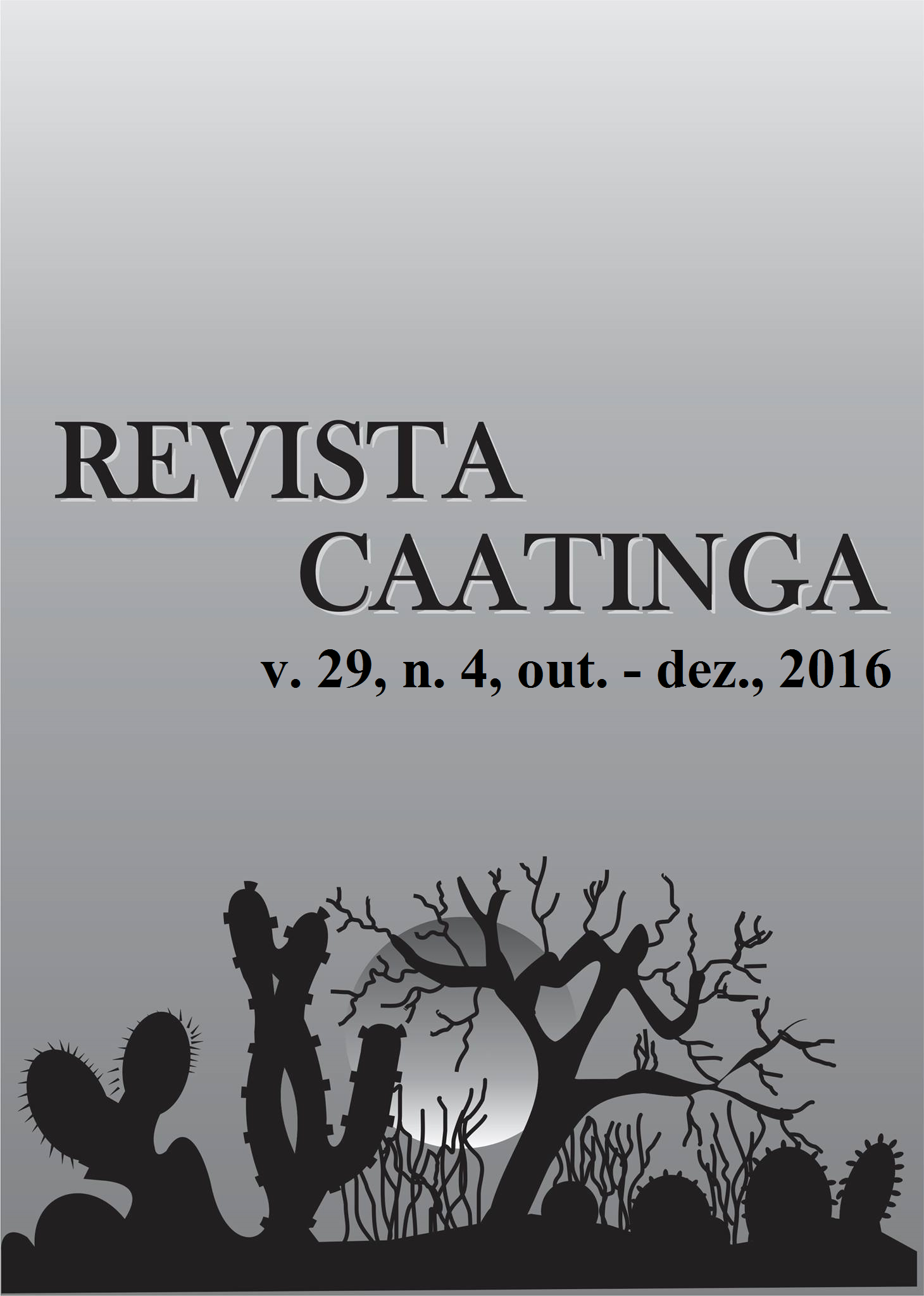SELECTIVITY OF HERBICIDES APPLIED IN POST-EMERGENCE OF SHOWY CROTALARIA
DOI:
https://doi.org/10.1590/1983-21252016v29n417rcKeywords:
Crotalaria spectabilis. Cover crops. Intoxication by herbicides. Weed management.Abstract
Weed control is essential to reduce or eliminate the interference of weeds on crops. Chemical control with the application of herbicides consists of the most used method, with this aim in grain producing areas. Information about the selectivity of herbicides to C. spectabilis (showy crotalaria) are scarce, which are critical for the management of this species as a crop. One field experiment was performed to evaluate the selectivity of herbicides applied in post-emergence of showy crotalaria. The herbicides bentazon (720 and 576 g ha-1), imazethapyr (106 and 79.5 g ha-1), pyrithiobac-sodium (84 g ha-1), flumiclorac (60 g ha-1), flumiclorac in sequential application (30 / 30 g ha-1), imazethapyr + bentazon (106 + 480 g ha-1), and clethodim + quizalofop (96 + 100 g ha-1) were applied in plants with four true leaves, also using a control without herbicide application. Pyrithiobac-sodium and flumiclorac isolated and the tankmix of imazethapyr + bentazon provided greater injuries to showy crotalaria, also affecting the final plant height. Pyrithiobac-sodium (84 g ha-1) was not selective to showy crotalaria. The herbicides imazethapyr (79.5 g ha-1), flumiclorac (sequential application), and bentazon (576 g ha-1), despite the association between clethodim + quizalofop, can be used for weed management in showy crotalaria crop.Downloads
References
CONSTANTIN, J. et al. Controle de diferentes espécies de guanxuma com aplicações sequenciais de flumiclorac-pentil. Acta Scientiarum. Agronomy, Maringá, v. 29, n. 4, p. 475-480, 2007.
EWRC (European Weed Research Council). Report of 3rd and 4th meetings of EWRC – Committee of Methods in Weed Research. Weed Research, Oxford, v. 4, n. 1, p. 88, 1964.
FERREIRA, D. F. Sisvar: a computer statistical analysis system. Ciência e Agrotecnologia, Lavras, v. 35, n. 6, p. 1039-1042, 2011.
GHANIZADEH, H.; LORZADEH, S.; ARYANNIA, N. Effect of weed interference on Zea mays: Growth analysis. Weed Biology and Management, Kyoto, v. 14, n. 2, p. 133-137, 2014.
HARKER, K. N.; O'DONOVAN, J. T. Recent weed control, weed management, and integrated weed management. Weed Technology, Champaign, v. 27, n. 1, p. 1-11, 2013.
HOWARD, J. L.; RIDLEY, S. M. Acetyl-CoA carboxylase: a rapid novel assay procedure used in conjunction with the preparation of enzyme from maize leaves. FEBS Letters, Heidelberg, v. 261, n. 2, p. 261-264, 1990.
MONQUERO, P. A. et al. Seleção de espécies de adubos verdes visando à fitorremediação de diclosulam. Planta Daninha, Viçosa, v. 31, n. 1, p. 127-135, 2013.
MOURELOS, C. A. et al. Gramineous and non-gramineous weed species as alternative hosts of Fusarium graminearum, causal agent of Fusarium head blight of wheat, in Argentina. Crop Protection, Guildford, v. 65, n. 1, p. 100-104, 2014.
NORSWORTHY, J. K. et al. Reducing the risks of herbicide resistance: best management practices and recommendations. Weed Science, Champaign, v. 60, n. 1, p. 31-62, 2012.
OLIVEIRA JR., R. S. et al. Aplicações sequenciais de flumicloracpentil para o controle de Euphorbia heterophylla na cultura da soja. Acta Scientiarum. Agronomy, Maringá, v. 28, n. 1, p. 115122, 2006.
PROCÓPIO, S. O. et al. Seleção de plantas com potencial para fitorremediação de solos contaminados com herbicida trifloxysulfuron sodium. Planta Daninha, Viçosa, v. 22, n. 2, p. 315-322, 2004.
RODRIGUES, A. C. P. et al. Períodos de interferência de plantas daninhas na cultura do sorgo. Planta Daninha, Viçosa, v. 28, n. 1, p. 23-31, 2010.
RONCHI, C. P. et al. Manejo de plantas daninhas na cultura do tomateiro. Planta Daninha, Viçosa, v. 28, n. 1, p. 215-228, 2010.
ROSA, J. M. O.; WESTERICH, J. N.; WILCKEN, S. R. S. Reprodução de Meloidogyne javanica em olerícolas e em plantas utilizadas na adubação verde. Tropical Plant Pathology, Brasília, v. 38, n. 2, p. 133-141, 2013.
SOCIEDADE BRASILEIRA DA CIÊNCIA DAS PLANTAS DANINHAS – SBCPD. Procedimentos para instalação, avaliação e análise de experimentos com herbicidas. 1. ed. Londrina, PR: SBCPD, 1995. 42 p.
SORATTO, R. P. et al. Produção, decomposição e ciclagem de nutrientes em resíduos de crotalária e milheto, cultivados solteiros e consorciados. Pesquisa Agropecuária Brasileira, Brasília, v. 47, n. 10, p. 1462-1470, 2012.
TIMOSSI, P. C. et al. Supressão de plantas daninhas e produção de sementes de crotalária, em função de métodos de semeadura. Pesquisa Agropecuária Tropical, Goiânia, v. 41, n. 4, p. 525-530, 2011.
Downloads
Published
Issue
Section
License
Os Autores que publicam na Revista Caatinga concordam com os seguintes termos:
a) Os Autores mantêm os direitos autorais e concedem à revista o direito de primeira publicação, com o trabalho simultaneamente licenciado sob a Licença Creative Commons do tipo atribuição CC-BY, para todo o conteúdo do periódico, exceto onde estiver identificado, que permite o compartilhamento do trabalho com reconhecimento da autoria e publicação inicial nesta revista, sem fins comerciais.
b) Os Autores têm autorização para distribuição não-exclusiva da versão do trabalho publicada nesta revista (ex.: publicar em repositório institucional ou como capítulo de livro), com reconhecimento de autoria e publicação inicial nesta revista.
c) Os Autores têm permissão e são estimulados a publicar e distribuir seu trabalho online (ex.: em repositórios institucionais ou na sua página pessoal) a qualquer ponto antes ou durante o processo editorial, já que isso pode gerar alterações produtivas, bem como aumentar o impacto e a citação do trabalho publicado (Veja O Efeito do Acesso Livre).







